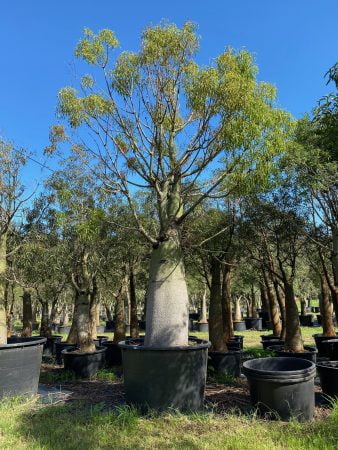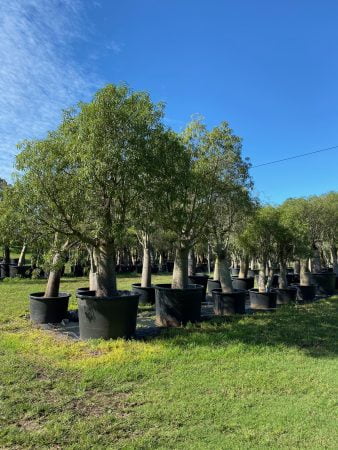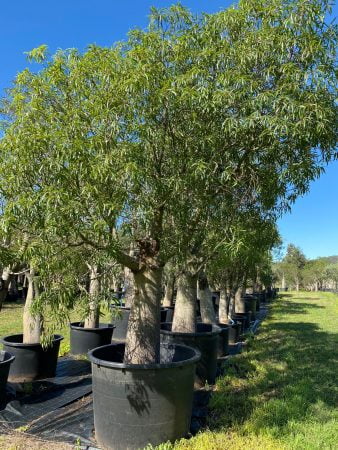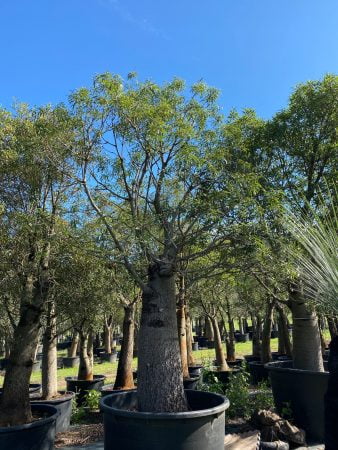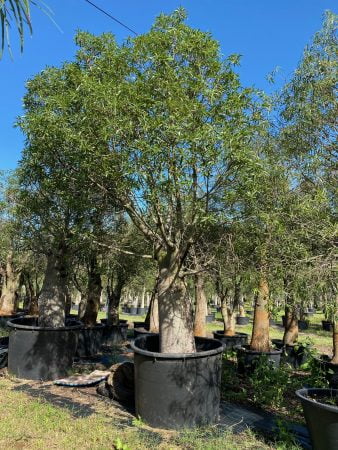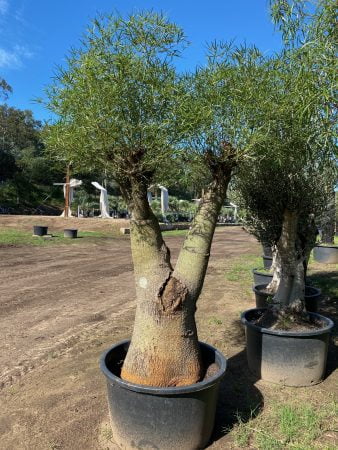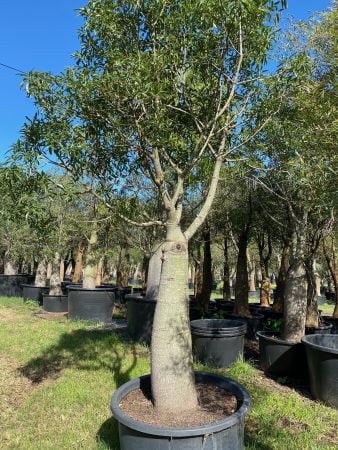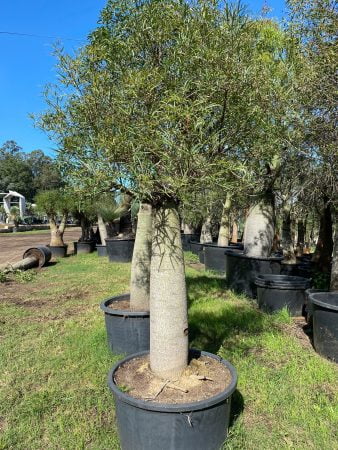Bottle Tree
Queensland Bottle Tree (Brachychiton rupestris)
| Scientific name: | Brachychiton rupestris |
|---|---|
| Common names: | Queensland Bottle Tree, Narrow Leaved Bottle Tree, Bottle Tree, Queensland Barrel Tree, Australian Barrel Tree, Dandygook, Kurrajong, Queensland-Flaschenbaum |
| Synonyms: |
|
| History: | The Queensland Bottle Tree was discovered by Sir Thomas Mitchell and John Lindley in 1848 at Mount Abundance (near present day Roma), Queensland, Australia. |
| Uses: | Aboriginal people carved holes into the soft bark to create reservoir like structures; consumed the seeds, roots, stems and bark; and the fibres were used to make twine, rope and nets. The soft, edible pulp is considered to be energy rich but protein poor.
Queensland farmers have been known to fell whole trees to feed stock during drought conditions. |

About the Queensland Bottle Tree
The Queensland Bottle Tree is a stunning, easy-to-grow specimen tree native to Queensland, Australia.
The Queensland Bottle Tree is unique to Australia, although it has been successfully transplanted to areas such as southern California in the United States. Its primary growing region, as should come as no surprise given the name, is in Queensland, Australia and in New South Wales.
Native to the stretch of Australia between northern New South Wales and the inland part of Queensland, the Queensland Bottle Tree is semi-deciduous. While it retains its leaves through the winter, it drops them in the spring, making way for a sprinkling of creamy yellow flowers. These delicate flowers eventually flutter their way down to the ground, resulting in a colourful carpet around the tree’s base.
One of the outstanding features of the Queensland Bottle tree is its bulbous trunk which, after around 10 years of growth, can be as large as 4 metres in diameter. This tree is extremely drought tolerant but ideally likes plenty of water which it stores between the inner bark and the trunk. This gives it its unique shape and the reason for its common name of the “Bottle Tree”.
Its scientific name is Brachychiton rupestris. The name comes from its oddly shaped trunk, which resembles a chubby, narrow-necked bottle. The Queensland Bottle Tree does not have any known subspecies but does have some relatives: the Proserpine Bottle Tree, or Brachychiton Compactus, which can only be found near Proserpine, and the Ormeau Bottle tree, which is similar to the Proserpine Bottle Tree, with only slight variations in leaf colour and shape.
Bottle Trees can grow in a wide variety of soils and aspects and can sustain temperatures from -5 to +45 degrees. They can be used to provide shade from the sun and shelter from the wind. The Bottle Tree is very versatile and easy to grow and will make a fantastic addition to just about any location or environment.
Frequently Asked Questions
Do Bottle Trees need much water?
The Queensland Bottle Tree requires very little, if any, ongoing care and maintenance. Although drought tolerant it does like to be watered regularly during the summer. Due to its amazing water storage capabilities, the Queensland Bottle Tree is drought and wind tolerant.
Continue reading about Bottle Tree care.
How tall can a Bottle Tree grow?
The Queensland Bottle Tree is an oddly shaped but stunning deciduous tree that grows to around 18-20 metres tall and has a dense, rounded canopy that can reach 5-12 metres in diameter. (Trees may be smaller in cultivation or cooler climates.)
Continue reading about Bottle Tree growth.
How can I propagate a Bottle Tree?
The Queensland Bottle Tree is easily propagated from seed but care must be taken to wear gloves whilst extracting seeds as the pods contain hairs that can cause skin irritation. Stem cuttings of semi-ripe growth will root well.
Continue reading about Bottle Tree propagation.
Where can I buy a Bottle Tree?
We are one of the leading suppliers of Bottle Trees in Australia. We are fully licensed by the NSW Office of Environment and Heritage to sustainably harvest several species and we are proud to say that we have one of the largest ranges of Bottle Trees.
Click here to get a quote.
Our Bottle Trees
We have a wide range of Bottle Trees available to suit any budget. They are perfect as a feature tree in any landscape and have a real wow factor!
- Bottle Tree 11
- Bottle Tree 21
- Bottle Tree 12
- Bottle Tree 20
- Bottle Tree 19
- Bottle Tree 18
- Bottle Tree 17
- Bottle Tree 16
Queensland Bottle Tree: Learn more
The Queensland Bottle Tree used to be primarily used as a feature tree in larger landscapes – when given the space to thrive, its bottle-shaped trunk really stands out, making it a fantastic focal point. However, growing this tree in pots is becoming more popular too, especially in smaller gardens, and many have also successfully cultivated indoor bonsai versions.
This increase in interest has come about at just the right time – the Queensland Bottle Tree is now a protected species, meaning that it can no longer be harvested from the wild. Therefore, our Bottle Trees are all sourced from sustainable plantations or grown on one of our farms. Our trees are grown to suit the urban environment, typically between 3 to 4 metres in height.
It plays an important role in what has now become an endangered ecosystem; the way in which it emerges from above other trees and plants enables it to provide a safe habitat for several native species, many of which are now endangered.
Queensland Bottle Tree: Planting
The Queensland Bottle Tree is extremely easy to grow. It adapts readily to cultivation due to its tolerance for a wide range of soils, aspects and temperatures. It really is not too fussy!
Although it grows slowly, it doesn’t require much care or maintenance and is adaptable to many different growing conditions. Frost, drought, and extreme heat doesn’t scare this tree – it can even withstand bushfires! It responds with a vivid display of flowers, which is then followed up by lush new foliage.
It is best planted as a specimen tree in a space where its spectacular shape can be fully appreciated. It can also be planted to provide shelter from both the sun and the wind. The Queensland Bottle Tree can also be cultivated indoors and is even used for bonsai specimens.
Bottle Trees grow best in deep, well-drained, slightly acidic soil (pH 5.5-6.5) and in full sunshine. They transplant easily (it is widely reported that they can withstand intervals of up to three months between digging and replanting, with no detrimental effects!) and minimal soil preparation is required for planting.
Organic matter can be incorporated into the planting hole and a thick layer of gravel or pine bark mulch can be added after planting. Take care not to mulch too close to the stem of the tree as this will encourage rotting. Neither of these actions is absolutely necessary but they both help with moisture retention and mulching can offer a level of protection for the roots during cold periods.
Due to its amazing water storage capabilities, the Queensland Bottle Tree is drought and wind tolerant but it may drop some leaves during dry spells – do not be alarmed if this happens! The healthiest plants are known to grow in areas that experience prolonged dry periods as the roots will grow very deep in search of water.
It is also classed as a second-line coastal plant meaning that it should be able to withstand moderate coastal exposure but it does grow best when protected from salt-laden winds.
The Queensland Bottle Tree is tolerant of light frosts and usually hardy at temperatures down to -5 degrees. It grows at its best within a temperature range of -5 to +45 degrees and is suited to most climate ranges.
Queensland Bottle Tree: Ongoing Care & Maintenance
The Queensland Bottle Tree requires very little, if any, ongoing care and maintenance. Although drought tolerant it does like to be watered regularly during the summer.
Feeding is not usually necessary unless it’s pot grown, but you can feed with a balanced complete fertiliser once a year typically in spring to maintain vigour. The Queensland Bottle Tree is generally pest and disease free but feeding may encourage lush leafy growth which may attract the Kurrajong Leaf Roller Caterpillar or birds looking for shelter.
Pruning is also not necessary but it will respond well to light pruning if planted in a situation where size or shape needs to be controlled.
The tree can drop its leave prior to flowering typically between the months of September and December. This will result in a new flush of fresh leaves and gives the tree a new burst of life.
Thanks to their slow growth, Queensland Bottle trees can be grown as container plants or made into bonsai. Their unique shape creates a conversation piece even for people who might not ordinarily be interested in plants.
Bottle trees are hardy growers, and are both drought and sun tolerant. They are a perfect tree for xeriscape landscaping, requiring little care once they are established.
Queensland Bottle Tree: Propagation
The Queensland Bottle Tree is easily propagated from seed but care must be taken to wear gloves whilst extracting seeds as the pods contain hairs that can cause skin irritation.
Stem cuttings of semi-ripe growth will root well and can be taken from late Summer to early Autumn. The application of rooting hormone to the base of the cuttings and the use of bottom heat will help to improve the success rate.
As previously noted, bottle trees can be cultivated. To date, the “tame” trees have not grown as large as those in the wild, but they have exhibited a unique attribute. It is possible to dig up and move quite a large bottle tree which means that even if you are renting, you can take your bottle tree with your when you move.
A row of 93 commemorative bottle trees was planted after World War II, one for each local man who had fallen. Because of their interesting shape, they are often used in botanical gardens and parks to lend interest and add shade.
They can be grown in places other than Australia, including zones 9 through 12 in the United States. As previously noted, they have been successfully grown in southern California. They are easy to move, and even fairly mature trees can go two or three months without being replanted.
Young bottle trees are very slow-growing, taking as long as nine or ten years before the distinctive bottle shape begins to appear. They can also be grown from seed or from cuttings, if the cuttings are taken at the end of summer, then given hormone treatments and encouraged with bottom heat.
Bottle trees are deciduous, but in some regions, they might lose their leaves a section at a time, rather than losing them all at the same time.
Queensland Bottle Tree: Taxonomy and naming
The Queensland Bottle Tree has been subject to naming confusion. Sir Thomas Mitchell first brought the bottle tree to the attention of the scientific community, describing it as having a barrel-like trunk. He and John Lindley, a botanist, designated the tree as Delabechea rupestris, in honour of Henry de la Beche, director of the geological survey by Great Britain. The government botanist in Victoria, Ferdinand von Mueller renamed it Brachychiton and considered it a subspecies of sterculia.
After several more changes, in 1988, Gordon Guymer, a botanist at Queensland Herbarium, did some extensive plant classification work for Australian plants. He designated the bottle tree as a Brachychiton (which means “short tunic”, and refers to the structure of the seed coats), clade Australasian, subfamily Sterculioideae, and only distantly related to sterculia. He designated the Queensland tree and the Proserpine tree as falling under the section Delabechea and labelled them both as Brachychiton rupestris. Or you can simply call it the “narrow-leafed Queensland bottle tree.”
Family: Malvaceae
Genus: Brachychiton (From Greek ‘Brachys’ meaning ‘short’; and ‘chiton’ meaning ‘tunic’ – a reference to the seed coats.)
Species: Rupestris (Meaning living among the rocks – a reference to the rocky hilltop habitat in which they were discovered)
Synonyms:
- Brachychiton delabechei
- Clompanus rupestris
- Delabechea rupestris
- Sterculia rupestris
Common names: Queensland Bottle Tree, Narrow Leaved Bottle Tree, Bottle Tree, Queensland Barrel Tree, Australian Barrel Tree, Dandygook, Kurrajong, Queensland-Flaschenbaum
Queensland Bottle Tree: History
The Queensland Bottle Tree was discovered by Sir Thomas Mitchell and John Lindley in 1848 at Mount Abundance (near present day Roma), Queensland, Australia. It was named by its discoverers after its bulbous trunk which was described as bottle like or barrel like.
Between 1918-20 it was planted as an avenue feature tree in Roma, Queensland. Each tree was chosen to represent one of 93 local men killed in the First World War. Roma purportedly has the largest Queensland Bottle Tree in the world measuring over 9 metres in circumference.
It didn’t take long for the tree’s incredible tolerance to be discovered in the late 1900s, which is why you will now find the Queensland Bottle Tree growing throughout Australia, as well as in other parts of the world. Since mature specimens can survive up to three months out of the ground before being re-planted, even with barely any roots attached, this has become a highly sought-after tree. Southern California has been especially successful at cultivating the tree, possibly due to the state’s climatic similarities with the drought and dryness of Australia. Although the cultivated trees don’t tend to grow as large as their wilder counterparts, they never fail to be a show-stopper in the landscape that they are planted in.
Queensland Bottle Tree: Distribution and Habitat
The Queensland Bottle Tree grows native from central Queensland through to northern New South Wales; latitudes 22 degrees South to 28 degrees South.
It is usually found growing towards the top of hills and it has been seen to grow in shale, basalt, medium to heavy clay, silt , sand and volcanic rock.
There are several bottle tree varieties out there, but none have a trunk quite as bulbous and shapely as the Queensland Bottle Tree. If you have been looking for an easy-to-grow tree to add to your garden, this is one that never fails to be a conversation-starter. While you may need to wait a few years for its bottle shape to develop, an established tree can live for hundreds of years and only becomes more impressive with age, making it well worth the investment.
Queensland Bottle Tree: Conservation
The Queensland Bottle Tree is listed as ‘least concern’ under Queensland’s Nature Conservation Act and is not considered by The Australian Native Plants Society (Australia) to be ‘at risk in the wild’. But, it is classed as a key component and emergent tree species in the endangered ecosystems of the Queensland Brigalow Belt known as ‘semi-evergreen vine thickets’ or ‘Bottle Tree Scrub’. Its range is found to be declining and the health of any trees that remain in cleared areas may also be compromised.
Queensland Bottle Tree: Appearance
The Queensland Bottle Tree is an oddly shaped but stunning deciduous tree that grows to around 18-20 metres tall and has a dense, rounded canopy that can reach 5-12 metres in diameter. (Trees may be smaller in cultivation or cooler climates.)
The outstanding feature of this plant is its unusual trunk which becomes bottle shaped at around 5-8 years old and can measure up to 3.5-4 metres in diameter at breast height (DBH). At maturity, between 5-15 metres of the tree is usually trunk. The bark is smooth and green/grey on smaller branches and the stem of young plants. Mature trunks are generally dark grey/brown with deep fissures.
Leaf blades are narrow and can be deeply divided. They are elliptic, almost finger-like in shape. They measure approximately 4-11cm long and 2cm wide. The leaves are a glossy dark green on the upper surface and a lighter green underneath. Juvenile leaves are compound with 3-9 narrow, spear shaped or linear lobes. Young growth often has a reddish tinge.
The Queensland Bottle Tree flowers from September to October. Its flowers are bell shaped with cream and red petals that are slightly twisted. The flowers are not especially conspicuous being only around 6-8mm long and 10mm wide but, with 10-30 flowers per panicle, they put on a pretty little show.
Seed pods form and ripen from November to May in groups of 3-5 boat shaped pods which are approximately 30mm long and 10-15mm wide. They are smooth and brown on the outside and hairy on the inside and each pod contains 2-8 hard, yellow, egg-shaped seeds.
Queensland Bottle Tree: Ecology
Although there seem to be several variations on the bottle tree, the Queensland bottle tree is the largest, growing sometimes to as tall as 60 feet. The Queensland bottle trees located in the evergreen vine thickets in the Brigalow Belt and Nandewar bioregions. The giant bottle trees are emergent trees, that is, they stick out above the other growth, providing a unique habitat for top dwelling birds, animals, insects, and reptiles. Although the trees are not considered endangered at this time, the ecosystem is considered to be under threat.
The Queensland Bottle Tree is a host plant for the Mistletoe species Dendrophthoe glabrescens. It hosts insects such as the Pale Cotton Stainer Bug, Harlequin Ladybird and Kurrajong Leaf Roller Caterpillar. The flowers are attractive to moths and its lush canopy provides excellent shelter for birds.
Bottle Tree Scrub is a key habitat for the near threatened Black-breasted Buttonquail.
The tree can withstand bushfires and will respond by flowering and putting on new growth.
Bottle tree are an important component of bottle tree scrub, which provides shelter for several native species, some of which are endangered. They are susceptible to insects and diseases that are associated with imported species and farm crops. The trees, themselves, are amazingly edible, for both human and animals.
Queensland Bottle Tree: Uses
As a plentiful source of moisture, Aboriginal people used the Bottle Tree extensively. They carved holes into the soft bark to create reservoir like structures; consumed the seeds, roots, stems and bark; and the fibres were used to make twine, rope and nets. The soft, edible pulp is considered to be energy rich but protein poor.
Queensland farmers often leave remnant trees for shade or fodder when clearing the land and have been known to fell whole trees to feed stock during drought conditions. Occasional cases of nitrate poisoning have led to cattle deaths.
Looking for a Queensland Bottle Tree? Click Here to Request a Quote.
Request A Quote Now.
Call Us For An Instant Quote!
Australia:
0461 486 193
International:
+61 461 486 193
Email – hello@designertrees.com.au
